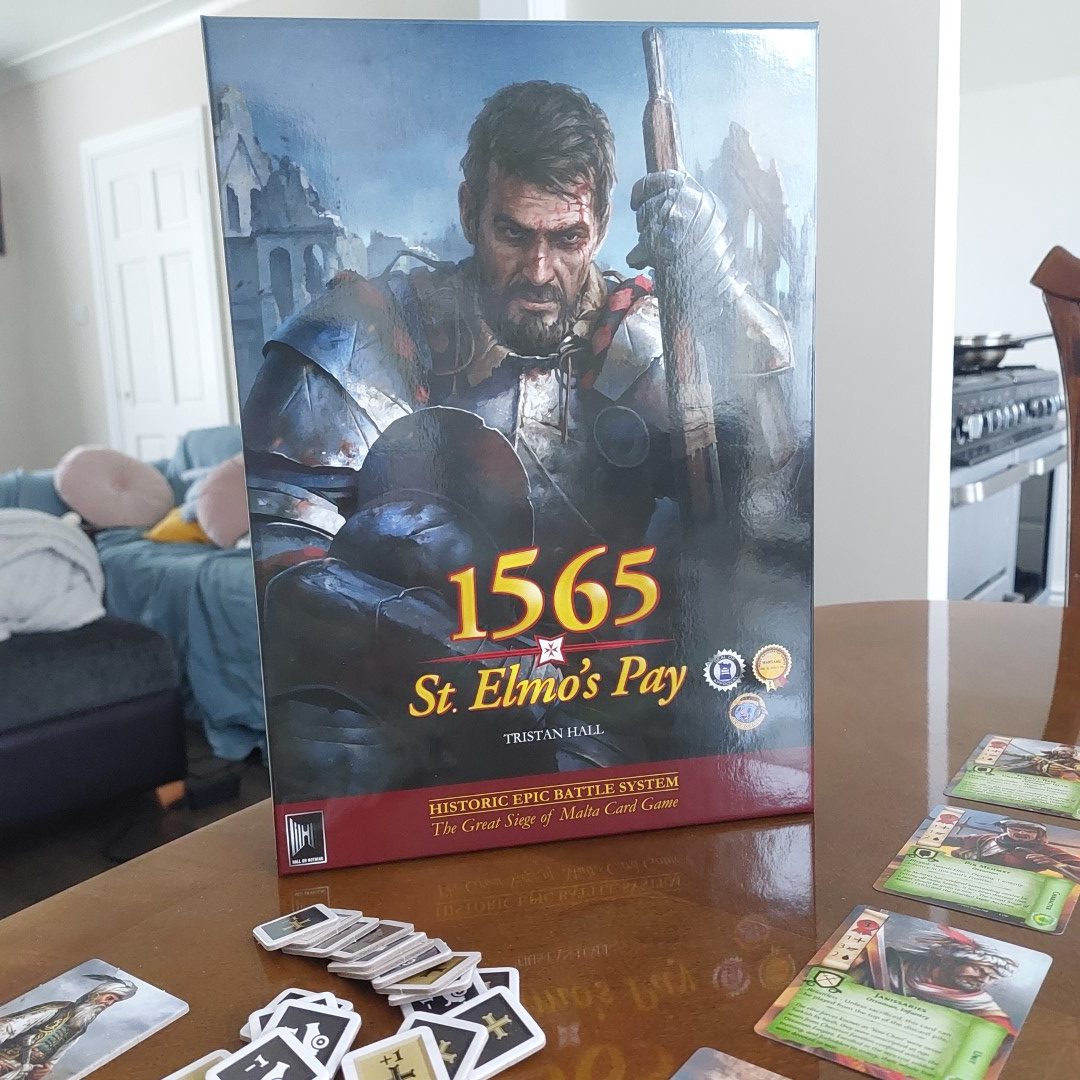1565 St Elmo’s pay (referred to as 1565 from here onwards) is a game in the same system and sees the attention drawn to the Greatest Siege in History. As I’m unlikely to get 1565 to the table in a head-to-head capacity, this review will focus largely on the solo experience. However, based on my enjoyment of 1066 in the same system as a head-to-head game, I have a suspicion this will equally as enjoyable and I never tried 1066 solo.
Having recently reviewed Shores of Tripoli, you could say I’m in my war game era? And 1565: St Elmo’s Pay focuses on the conflict between the forces of Suleiman the magnificent’s and the Knights of St. John’s, which sees a force of 30,000 strong lay siege to 500 knights (I’m sure there’s probably a better historical description.). I guess like Shores of Tripoli, I know very little about the conflict beforehand, however, this game has caught me and had me researching the events of 1565.
The aim of 1565 is to be the first player to either: destroy two frontiers or destroy your opponent’s leader, or have your opponent run out of cards. 1565 is played over several rounds, in which players take turns to play cards to fulfil firstly their objectives and then participate in what is effectively the final battle.
There’s a strong sense of escalation here, in that those first few rounds feel almost uneventful, as you chip away at objectives, before the big finale.
Each round is split into 3 and a bit phases, although the rulebook lists 4, depending on the objectives you’ll most likely either skip one phase or the other or part of one.
The first phase is essentially the draw phase, in which you draw cards to your hand. And also, a potential end game point, if you or your opponent has no cards left to draw, that’s game over!
The deployment phases, feels like where you will spend the bulk of your actions, taking turns back and forth until players pass, with the actions you can take in the deployment phase being: Play a card, execute an action, sacrifice a card, or pass. The abilities you can activte by “tiring” a card typically range from reduce the cost, destroying a card, discarding cards, although there is a mixture of response abilities that you can initiate if their triggering condition is met.
1565, forces you to choose which cards to play and which cards to essentially discard, meaning each game is likely to play out differently. As you’ll on average probably get rid of half your deck to pay the costs for the other half you choose to play, meaning there’s a good sense of replayability and variability here, although that does mean historical ordering is somewhat thrown out of the window as events can happen in a somewhat random order. You can also “tire” a ready card in play to generate resources, but then that can compromise you in the later phases. There’s some antagonising decisions in 1565, that are somehow incredibly addictive and satisfying. There’s a mixture of tactic, units and attachment cards you can deploy to your side of the frontier, however, for every card you play, you are very likely to be throwing others to the discard pile. In my first few games, this decision didn’t feel like it had much weight, but as I became more familiar with the cards at my disposal, this more seemingly more meaningful and very much at times a “I want to keep them all, but I need to play something” decision.
The frontier phase is very likely to be skipped for the first few turns (probably first 10-15 minutes) until a player has reached the objective “The great siege of malta”, and both players will need to have reached the objective to resolve a might combat. Otherwise, you’ll resolve zeal combat, which works largely the same way, summing up the total zeal value of all cards in each frontier and then dealing one damage to the frontier if they have the highest zeal total. If players tie, each player deals a single damage to the frontier. Might combat is resolved slightly differently in that you deal damage equal to the amount your might exceeds your opponents might. However, the key here is that if you have not yet reached Malta, you cannot cause damage, you can only effectively prevent your opponent from getting an early head start by ensuring you have a strong presence in Malta to not allow your opponent to claim a significant advantage.
As a Solo experience the game plays very similarly, with some minor rule tweaks, after each deployment the AI bot takes a turn working through its actions artillery, range or deployment, early on I thought I was in for a breeze, as the easy bot has a -1 resource cost, but early game it drew a card that allowed it to play another at –3 discount, meaning there was a big unit present, which was then followed by another as the newly placed card generated resources. And the bot takes end of round actions, which meant another deployment – although at this point it had luckily used its resources. There’s multiple difficulty levels, which speaking as someone who has only played the first two levels, feels like the higher levels most be mountains to climb. As there’s a much higher threat level of new units constantly arriving and engaging your forced with ranged attacks.
As someone who felt gripped by the artwork, I would have liked a supplementary document or two, to give me a bit more historical background. This is something Fort Circle Games included in everyone of their games and it feels like a nice added touch. Although that’s no complaint, more of a nice to have, but my actual issues are with the rulebook and the lack of examples, there are none, well there is one to show you how cards move up, but no others and it really feels like its missing one or two. I found that I read a rule one way, then would go back, re-read it and then it would click, as much as I love the system and having played it before, it all felt largely familiar, just a few examples could vastly improve the learning experience. Even after a handful of games, I find myself going back to the rules seeking clarifications that could be solved with examples.
As you know, I rate games on a scale of
– Buy or play
– Wait for sale or play if you like game XYZ
– Avoid
This almost, almost gets a buy recommendation. For me this scratches a netrunner/LCG game itch that is immensely satisying. However, I recognise that head to head style of card games aren’t for everyone. Fundamentally as much as I love the artwork, that honestly is probably some of the best I’ve seen recently. The rulebook is where I’d like to see future improvements with examples throughout. If you enjoy head to head style games like Summoners wars, Memoir 44and I’d say even Magic the gathering, pokemon and want to mix up the game system. This gets a easy Play recommendation. However, the war theme and Blood stained battle hardened Character may be slightly off putting to some, maybe a retheme to soft and cuddly teddybears could be more appealing to non-history folk. So 1565 gets a “Wait for Sale or play if you enjoy head to head games”. Ultimately, I’ve really enjoyed my time with 1565 and having spent time thinking about “well if I just did that differently” or “If I’d play that card instead of that card” and that was about games I played at the weekend (it’s Thursday as I write this).
Disclaimer: I was sent a copy of 1565 to review by Hall or Nothing. I was not paid for this review. All thoughts remain my own.

